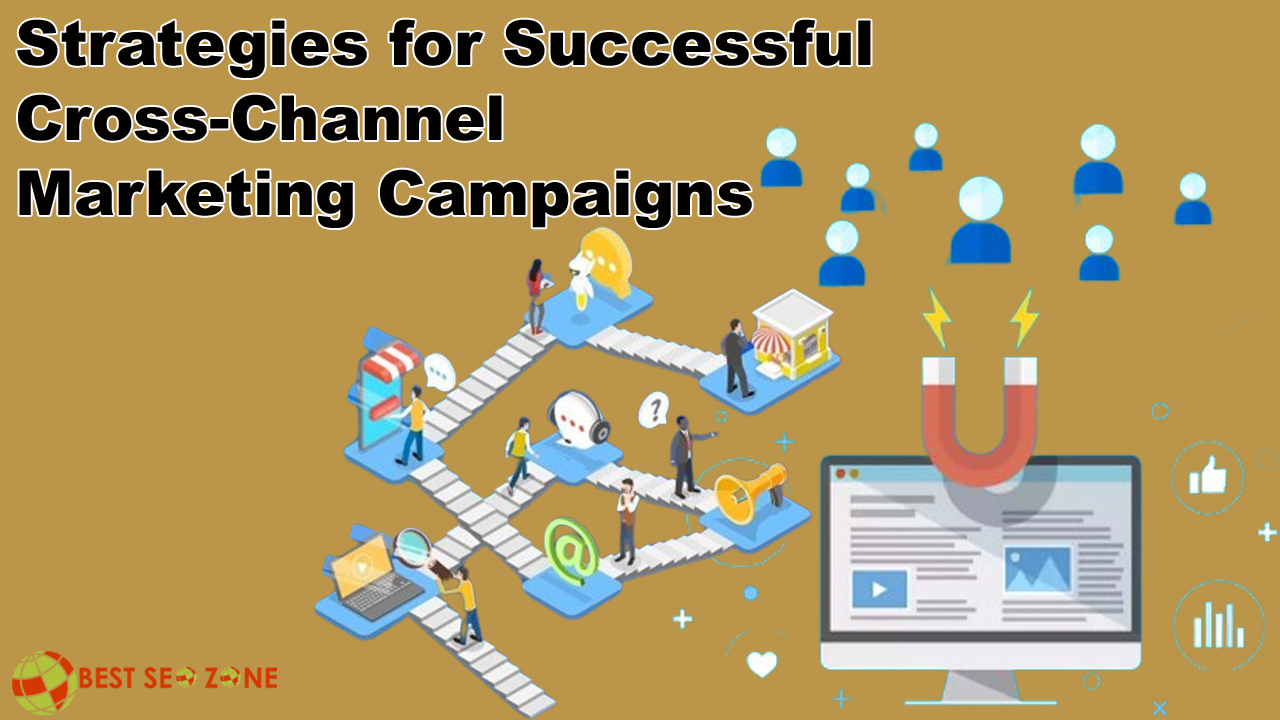Cross-channel marketing is like being a great host at a big party. For Example, if you have friends in different rooms some are in the living room others are in the kitchen and a few are hanging out in the backyard. Your job is to make sure you chat with all of them no matter where they are making each feel included and heard. That’s what businesses do with cross-channel marketing. They talk to their customers across different rooms or platforms like email social media and websites to ensure their message is heard loud and clear everywhere.
But just like at a party you need a plan to be a good host. You can not just randomly walk from room to room without knowing what you’ll say or do. In cross-channel marketing, this plan involves understanding who you are talking to, making your message fit each roo,m, and ensuring you’re speaking at the right time so everyone feels like they’re part of the fuIt’st’s all about creating a vibe that connects with everyone no matter where they are or what they are doing making your brand the life of the party.
Table of Contents
Understanding the Basics of Cross Channel Marketing
Cross-channel marketing is like being the conductor of an orchestra where each musician plays a different instrument. In this case, each instrument represents a different way to talk to customers like email social media mobile apps, and websites. Your job is to make sure that all these instruments work together in harmony playing the same tune. This does not mean playing the same note on every instrument but adjusting the melody to suit each one while keeping the overall song recognizable. The goal is to give your audience a consistent and seamless experience no matter how or where they hear your brand’s music. By carefully coordinating these different channels you can guide your customers on a journey that feels smooth and connected encouraging them to engage with your brand more deeply.
The magic of cross-channel marketing lies in its ability to create a cohesive story. This story unfolds across various platforms adapting to the strengths and audiences of each yet always remaining true to the core message. It’s about striking the right chord with your audience ensuring that whether they see your message on a billboard or hear it in a podcast it feels familiar and resonates with them. This approach helps build trust and loyalty as customers come to recognize and appreciate the consistent voice and experience your brand offers no matter where they encounter it.
Identifying Your Target Audience and Their Preferred Channels

Identifying your target audience and their favorite places to hang out online is a bit like being a detective. You start by gathering clues about who your audience is things like their age where they live what they’re interested in and what problems they’re trying to solve. Then you look for patterns to figure out where they spend their time online. Do they scroll through Instagram? Do they prefer reading emails? Or maybe they’re always on Twitter or watching videos on YouTube. By playing detective and putting these pieces together you can make an educated guess about the best places to share your messages. This way you’re not just shouting into the void you’re talking directly to the people who are most likely to listen and engage with what you have to say.
- Like being a detective gather clues about who your audience is including their age interests and what problems they’re trying to solve.
- Use the clues to discover where your audience likes to spend their time online whether it’s Instagram Twitter YouTube or reading emails.
- Tailor your message for each platform where your audience hangs out making sure it fits the style and tone they expect there.
- Instead of just talking to your audience look for ways to interact with them ask questions and get their opinions to make them feel involved.
- Keep an eye on how well your strategies are working by seeing how your audience responds and be ready to tweak your approach based on what you learn.
Crafting a Cohesive Brand Message
Crafting a cohesive brand message is like telling a great story that everyone wants to hear again and again. It starts with knowing exactly what your brand stands for what makes it unique and why people should care about it. This core message should be like a golden thread that runs through everything you say and do from the biggest billboard ad to the smallest tweet. It is about making sure that whether someone sees your message on TV reads about it in an email or comes across it on social media they instantly recognize it as yours. This does not mean repeating the same words everywhere but it does mean keeping the heart of your message the same so it feels familiar and trustworthy. The trick is to adapt your story to fit each place you tell it changing the style or tone if needed but never losing sight of the big picture. This way no matter how or where people hear about you they get a consistent sense of who you are and what you stand for making your brand more memorable and engaging.
Leveraging Technology for Seamless Integration

Leveraging technology for seamless integration is like using a smart toolbox that helps you make sure all the pieces of your marketing puzzle fit together perfectly without any gaps. Imagine you have a bunch of different tools like email social media your website and maybe even a mobile app. Technology especially marketing automation tools acts like a super smart assistant that helps you use all these tools together in harmony. It can automatically send out emails at just the right time to post to social media without you having to do it manually and make sure your messages on your website and in your app are all saying the same thing. Plus it gathers information about how well each piece is working so you can see what’s hitting the mark and what needs tweaking. This way your marketing efforts feel smooth and connected giving your audience a seamless experience no matter how they interact with your brand.
Personalizing the Customer Experience
Personalizing the customer experience is like being a thoughtful friend who remembers all the little details. It’s about paying close attention to what your customers like what they do and what they need and then using that knowledge to make their interactions with your brand feel special and tailored just for them. For example, if you know a customer loves running you can send them tips or offers related to running gear. This personal touch makes customers feel understood and valued like you’re speaking directly to them and not just sending out the same message to everyone. By using tools that track customer preferences and behaviors you can customize your emails social media messages and website to reflect what each customer enjoys or is interested in. This way every time they hear from you it reinforces the feeling that your brand gets them and cares about making their experience as enjoyable as possible.
Some Important Tips & Tricks
- Pay close attention to your customer’s actions and feedback across all your channels. Notice what types of products they browse what content they engage with and what questions they ask. Use surveys or social media to ask them directly about their preferences. This information is like gold for personalizing their experience.
- Break down your big customer list into smaller groups based on their interests buying behavior or how they found your brand. For example, you could have a group for customers who love outdoor sports and another for those who prefer indoor fitness. This helps you tailor your messages and offers to match what each group likes.
- Once you’ve segmented your audience start sending messages offers and content that fit each group’s interests. If someone loves reading recommend books or send them blog posts. For a fitness enthusiast share workout tips or special deals on gym gear. It’s all about making your communication feel like it’s been handpicked for them.
- Personalization is not a one-time thing it’s an ongoing conversation. Keep updating your customer profiles based on their latest interactions and feedback. This way you can keep refining your messages to stay relevant and engaging. Remember the more you show you understand and value your customers the stronger your relationship with them will be.
Timing and Coordination Across Channels

Timing and coordination across channels are like organizing a well-synchronized dance where every move happens at just the right moment. Imagine each marketing channel as a dancer’s email social media your website and maybe even text messages. For your marketing campaign to wow the audience all these dancers need to perform in perfect harmony hitting their cues at precisely the right times. This means planning carefully so that your message goes out across all channels in a coordinated way like launching a new product announcement on your website followed by emails to your subscribers and posts on social media all around the same time. This approach ensures that no matter where your customers hang out they get the message loud and clear and at the moment when it’s most relevant to them. Plus by keeping all your channels in sync you help reinforce your message through repetition without overwhelming your audience making it more likely they’ll remember and act on it.
5 Basic steps Guide to Creating a Cross-Channel Marketing Strategy
1 - Define Your Goals and Audience:
- Clearly articulate what you want to achieve through your cross-channel marketing efforts. Whether it's increasing brand awareness, driving sales, or launching a new product, make your goals specific and measurable.
- Ensure your goals are SMART (Specific, Measurable, Achievable, Relevant, and Time-bound). For example, "Increase website traffic by 20% in the next three months" is a SMART goal.
- Align your marketing goals with the broader business objectives. Understanding how your marketing efforts contribute to the overall success of the company ensures cohesion and strategic alignment.
- Establish baseline metrics to measure progress. Knowing where you currently stand allows you to gauge the effectiveness of your cross-channel marketing strategy over time.
2 - Understand Each Channel
Get to know where you want to talk to people. Different places like Facebook or emails work in unique ways. Some are quick like short messages on social media while others like emails allow for more details. Learn about these places what they’re good at and where they might not be as good. Understand the strengths and weaknesses of each place. Social media is good for fast updates while emails are good for more information. Know what each place does well and where it might not be as effective. Think about using these places together. You don’t have to stick to just one. For example, start with a quick hello on social media and then provide more details through emails. Figure out how these places can work together for your message to reach more people.
3 - Create Consistent Branding and Messaging
Make sure everything about your brand looks and sounds the same. This includes things like your logo colors and the way you talk about your stuff. When people see or hear about your brand it should feel familiar and not confusing. Imagine your brand is like a friendly face that people recognize easily. Use the same words and style across all the places you talk about your brand like on your website social media or ads. This helps people remember and trust your brand because it stays the same wherever they find it.
4 - Implement Cross-Channel Integration
Make all your different ways of talking to people work together smoothly. This means your messages should connect across various places like social media emails and ads. Think of it like all these channels are friends helping each other out. Use tools that make sure everything runs well like scheduling posts or sending messages automatically. When someone sees your brand on one channel it should feel related to what they see on another. This way people get a complete and clear picture of what your brand is all about no matter where they find you. It’s like making sure all your friends are on the same page and telling the same story.
5 - Analyze and Optimize Performance
- Implement tracking mechanisms and analytics tools to monitor the performance of each channel. Key performance indicators (KPIs) may include engagement rates, conversion rates, and customer acquisition costs.
- Regularly analyze the data and adjust your strategy accordingly. Identify successful channels and tactics, and optimize underperforming ones. A data-driven approach will help you refine your cross-channel marketing strategy over time.
Final Thoughts
Mastering the art of cross-channel marketing campaigns is like being the conductor of a grand orchestra where every instrument plays its part to create a beautiful harmony. By understanding your audience and where they like to spend their time crafting a message that resonates across all platforms using technology to keep everything running smoothly personalizing the experience for each customer and making sure your timing and coordination are spot on you can create a marketing symphony that captures attention and wins hearts. Remember the key to a successful cross-channel marketing campaign is not just about shouting your message from every rooftop. It’s about making sure that message is heard felt and appreciated by your audience no matter where they are. With these strategies in hand, you’re well on your way to building campaigns that not only reach across channels but also connect deeply with the people on the other side turning casual listeners into loyal fans.
FAQs
What is cross channel marketing?
Cross-channel marketing is when a business uses multiple ways to talk to its customers, like social media websites and text messages. It makes sure all these ways are connected and tell the same story. It’s like making sure every band member plays the same song so no matter where you hear it you recognize it and enjoy it.
Why is it important to know my audience?
Knowing your audience is super important because it’s like knowing what kind of music your friends like before you make them a playlist. If you understand what they enjoy what they need and where they like to hang out online you can make sure your messages and offers are something they’ll want to see and listen to.
How do I make sure my brand message is consistent across all channels?
Making sure your brand message is consistent is like telling the same story in different ways whether it’s a picture a video or a tweet. You want to make sure that no matter how someone hears about your brand the main points are the same so they always know it’s you. This might mean using the same colors logos and type of language everywhere you talk to your customers.
Can you give an example of personalizing the customer experience?
Personalizing the customer experience could be like if you run a bookshop and you know one of your customers loves science fiction books. You could send them an email when a new sci fi book comes out or offer them a special deal on their next science fiction purchase. It s about making them feel special and showing that you pay attention to what they like.
How important is timing in cross channel marketing
Timing in cross-channel marketing is super important because it’s like knowing the best time to serve dinner at a party. You want to make sure everything is ready and served when your guests are hungry not before or after. In marketing, this means sharing your messages at the right time when your customers are most likely to see them and react like sending a coffee coupon in the morning rather than late at night.

Rana Hassam is an expert in SEO backlinks, specializing in creating effective strategies to enhance online visibility. With a focus on building high-quality backlinks, Rana excels in optimizing websites for search engines, ensuring improved rankings and increased organic traffic. His dedication lies in providing top-notch services to boost online presence and maximize the impact of digital marketing efforts.




